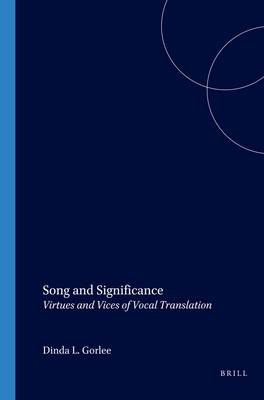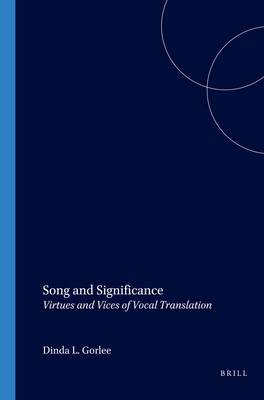
- Afhalen na 1 uur in een winkel met voorraad
- Gratis thuislevering in België vanaf € 30
- Ruim aanbod met 7 miljoen producten
- Afhalen na 1 uur in een winkel met voorraad
- Gratis thuislevering in België vanaf € 30
- Ruim aanbod met 7 miljoen producten
Zoeken
Song and Significance
Virtues and Vices of Vocal Translation
€ 163,45
+ 326 punten
Omschrijving
Vocal translation is an old art, but the interpretive feeling, skill and craft have expanded into a relatively new area in translation studies. Vocal translation is the translation of the poetic discourse in the hybrid art of the musicopoetic (or poeticomusical) forms, shapes and skills. This symbiotic construct harmonizes together the conflicting roles of music and language in face-to-face singing performances. The artist sings in an accurate but free flow, but sung in a language different from the original lyrics.
Vocal translation is a living-together community of composer and poet and translator; they work together though separately in time and place, through the structure and meaning of the vocalized verbal language. The meaning of the songs is influenced by the elements of musical expression: melody, impulse, pitch, duration, loudness, timbre and dynamics, each of which is governed by its own rules and emotions. The movement of the lyrics is an essential and meaningful attribute of the musical rhythms, pauses, pitches, stresses and articulations of the entire songs. The presence of the original and translated song structures its sounds, senses and gestures to suggest semiotic meaningfulness.
In opera, folksong, hymn and art song, as well as in operetta, musical song and popular song, we have musical genres allied to a libretto with lyrical text. A libretto is a linguistic text which is a pre-existing work of art, but is subordinated to the musical text. The essays in Song and Significance: Virtues and Vices of Vocal Translation provide interpretive models for the juxtaposition of different orders of the singing sign-events in different languages, extending the meaning and range of the musical and literary concepts, and putting the mixed signs to a true-and-false test.
Vocal translation is a living-together community of composer and poet and translator; they work together though separately in time and place, through the structure and meaning of the vocalized verbal language. The meaning of the songs is influenced by the elements of musical expression: melody, impulse, pitch, duration, loudness, timbre and dynamics, each of which is governed by its own rules and emotions. The movement of the lyrics is an essential and meaningful attribute of the musical rhythms, pauses, pitches, stresses and articulations of the entire songs. The presence of the original and translated song structures its sounds, senses and gestures to suggest semiotic meaningfulness.
In opera, folksong, hymn and art song, as well as in operetta, musical song and popular song, we have musical genres allied to a libretto with lyrical text. A libretto is a linguistic text which is a pre-existing work of art, but is subordinated to the musical text. The essays in Song and Significance: Virtues and Vices of Vocal Translation provide interpretive models for the juxtaposition of different orders of the singing sign-events in different languages, extending the meaning and range of the musical and literary concepts, and putting the mixed signs to a true-and-false test.
Specificaties
Betrokkenen
- Uitgeverij:
Inhoud
- Aantal bladzijden:
- 312
- Taal:
- Engels
- Reeks:
- Reeksnummer:
- nr. 25
Eigenschappen
- Productcode (EAN):
- 9789042016873
- Verschijningsdatum:
- 1/01/2005
- Uitvoering:
- Paperback
- Formaat:
- Trade paperback (VS)
- Afmetingen:
- 150 mm x 220 mm
- Gewicht:
- 521 g

Alleen bij Standaard Boekhandel
+ 326 punten op je klantenkaart van Standaard Boekhandel
Beoordelingen
We publiceren alleen reviews die voldoen aan de voorwaarden voor reviews. Bekijk onze voorwaarden voor reviews.










